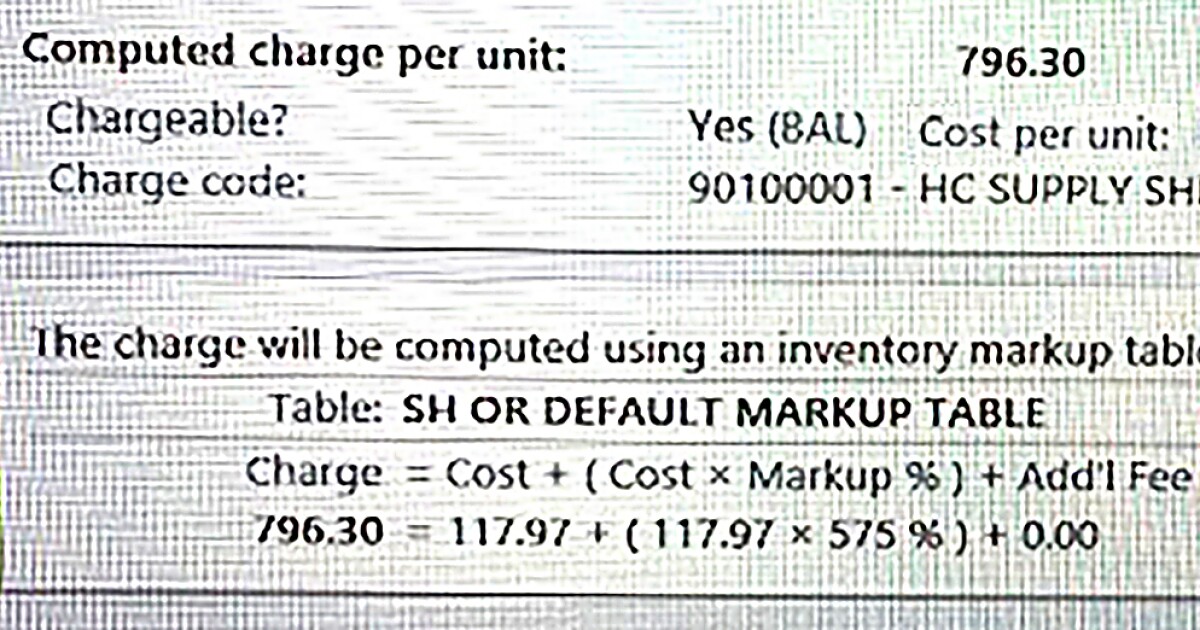Leaked Scripps information expose big mark-ups for healthcare facility care
6 min read
Preposterous, seemingly arbitrary cost markups are a defining attribute of the $4-trillion U.S. healthcare process — and a critical cause People pay back extra for treatment than anybody else in the entire world.
But to see price tag hikes of as considerably as 675% getting imposed in actual time, immediately, by a hospital’s laptop or computer process even now requires your breath away.
I got to see this for myself following a previous running-home nurse at Scripps Memorial Hospital in Encinitas shared with me screenshots of the facility’s electronic overall health report procedure.
The nurse asked that I not use her name mainly because she’s now doing the job at a different Southern California health-related facility and anxieties that her job could be endangered.
Her screenshots, taken before this calendar year, communicate for by themselves.
What they show are rate hikes ranging from 575% to 675% staying mechanically created by the hospital’s software package.
The eye-popping raises are so regimen, evidently, the software even displays the formula it works by using to transform acceptable medical charges to billed amounts that are considerably, a lot greater.
For example, a single screenshot is for sutures — that is, medical thread, a.k.a. stitches. Scripps’ program set the essential “cost per unit” at $19.30.
But the system said the “computed demand for every unit” was $149.58. This is how considerably the individual and his or her insurer would be billed.
The method helpfully bundled a formulation for reaching this quantity: “$149.58 = $19.30 + ($19.30 x 675%).”
You read through that correct. Scripps’ automatic process took the precise value of sutures, imposed an seemingly preset 675% markup and generated a billed quantity that was orders of magnitude better than the genuine price tag.
This is different from any more expenses for the health care provider, anesthesiologist, X-rays or medical center amenities.
Connect with it institutionalized price tag gouging. And it is apparently common for the reason that the exact same or equivalent software program is applied by other hospitals nationwide, which include UCLA, and all-around the environment.
The former Scripps nurse reported she resolved to snap photographs of the technique as she viewed stratospheric price hikes becoming imposed whilst a client was however on the functioning table.
She stated one particular of her careers in the operating place was to hold a functioning tally of all materials used for the duration of a method. As she entered just about every item into the method, it routinely famous the real cost and tabulated how substantially Scripps would invoice for it.
“I have an understanding of that hospitals have overhead,” the nurse told me. “But to mark up something like sutures by 675% is crazy.”
A different screenshot showed the pricing for an antimicrobial remedy to thoroughly clean the patient’s wound. Scripps’ expense per unit was $73.50. The billed amount of money was $496.13 — “$496.13 = $73.50 + ($73.50 x 575%)”.
Blades for a slicing instrument utilised by the surgeon had a price for every device of $98.53. Scripps’ billed selling price was $665.08 — “$665.08 = $98.53 + ($98.53 x 575%).”
“I commenced asking queries,” the nurse reported. “I was explained to that if we did not mark factors up like this, coverage organizations wouldn’t give us what we want.”
This is through-the-seeking-glass evidence of a little something I’ve penned about continuously.
Health care providers routinely disregard the precise value of treatment when calculating charges and rather cook up nonsensical figures to drive reimbursement from insurers higher.
For the millions of persons with out health insurance plan, these sky-high price ranges are what they’re stuck with (despite the fact that most hospitals, including Scripps, usually will offer you savings in this kind of situation).
I wrote a short while ago about a Valley Village woman who was billed $809 by a UCLA-affiliated clinic for a plastic boot for her broken foot. She located the correct same boot on Amazon for $80.
Which is to say, she was being billed a nearly 1,000% markup.
But chatting about it in the abstract or soon after the fact is 1 detail. Looking at a hospital’s laptop or computer program inflicting these value hikes even though procedure is remaining administered — that tends to make the exercise all way too genuine.
A dose of Floseal to limit a surgical patient’s bleeding experienced a essential value of $142.81, the Scripps screenshots display. The hospital’s cost: $963.97 — “$963.97 = $142.81 + ($142.81 x 575%).”
I shared the screenshots with Scripps and requested why this kind of staggering value will increase are evidently designed into the hospital’s automated method.
Janice Collins, a spokesperson for the hospital, declined to answer beyond confirming that the bigger amounts revealed in the screenshots replicate the hospital’s “chargemaster,” the inflated record price ranges utilized for haggling with insurers.
Collins sent me a assertion that characterised Scripps as a victim of circumstance, a hesitant participant in a health care procedure “that was proven a long time in the past and which is out-of-date.”
“Healthcare suppliers, together with Scripps, negotiate with health and fitness coverage corporations for what we will be compensated for these expert services,” the statement said.
“Health insurance coverage programs decide independently from health care companies what they will deal with vs. what individuals will shell out,” it claimed. “Neither the insurance coverage company nor the affected person normally pay out record rate.”
None of this is inaccurate. But Scripps’ response basically danced all over the edges of the concern at hand — specifically, a main health-related facility deliberately, and systematically, imposing substantial markups that in no way reflect its real treatment charges.
Scripps’ software is from a Wisconsin enterprise referred to as Epic, which states its applications have compiled health-related documents for a lot more than 250 million patients around the world.
Epic’s healthcare units consist of MyChart, the affected person portal made use of by several hospitals, as well as a broad wide variety of purposes meant for clinical settings.
Epic’s clientele include UCLA, UC San Diego, UC San Francisco, Stanford College, Johns Hopkins University and Yale University.
“Automate income and coding from medical activity to lower administrative overhead, stay away from missing costs, lower A/R days and enhance whole income,” the company’s web page claims. (A/R is quick for accounts receivable — the time that a payment is remarkable.)
I asked Epic if unique clients, which includes Scripps, ask for that the firm tailor its software package to their own needs by placing markups in advance.
“We really do not comment on our customers’ proprietary systems,” a spokesperson replied.
Questioned to remark on his own hospital’s Epic technique, Phil Hampton, a UCLA Wellness spokesperson, was similarly reticent.
“We know overall health insurance policies, billing and fees can be difficult,” he said, “and we encourage sufferers with concerns to speak to our brokers for clarification, facilitation of resolution with insurers if required and prospective economic aid.”
Scripps’ use of Epic’s software program sheds new mild on my previous column about the clinic, which concerned Scripps billing a client just about $80,000 for a method that Medicare stated need to expense less than $6,000 — a extra than 1,200% markup.
The bill integrated a roughly $77,000 cost for “medical providers,” which Scripps reported lined “technical company charges” these as “the facility, the surgical space, the gear, the support staff members.” That is, the program prices of running a medical center.
A solitary facility just can’t be held accountable for the dysfunctional, income-focused U.S. healthcare method. The concerns elevated right here use to each and every health-related facility in the place.
But a person frequent aspect of all U.S. hospitals is a desire to continue to keep their pricing below wraps, to stop people from figuring out how badly they and their insurers are becoming fleeced.
Maybe now that a smidge of sunlight has been permit in, we can have a a lot more straightforward conversation about repairing points.






